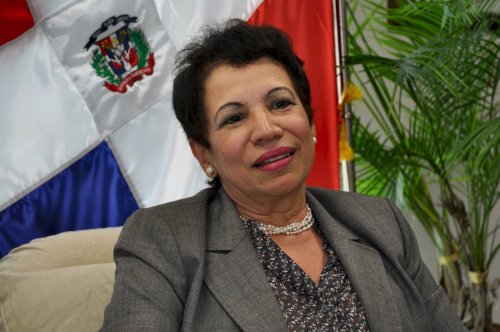Only Caribbean embassy in Seoul seeks green future, greater trade
Even before it fortified relations with Korea 49 years ago, the Dominican Republic sent material aid to support the country during the Korean War.
Both countries have experienced a progressive consolidation of ties ever since.
“However the true turning point in the enhancement of our ties was the official visit carried out in 2006 by President Leonel Fernandez,” said recently-arrived Dominican Republic Ambassador Grecia Fordalicia Pichardo.
Even before it fortified relations with Korea 49 years ago, the Dominican Republic sent material aid to support the country during the Korean War.
Both countries have experienced a progressive consolidation of ties ever since.
“However the true turning point in the enhancement of our ties was the official visit carried out in 2006 by President Leonel Fernandez,” said recently-arrived Dominican Republic Ambassador Grecia Fordalicia Pichardo.

The state visit opened a new chapter in relations with the signing of more than 20 cooperative agreements between the different agencies of both countries.
Programs currently underway include the Dominican Customs Modernization Project and the Knowledge Sharing Program between the Dominican Export and Investment Promotion Agency and the Korea Development Institute.
Other initiatives include the Dominican Immigration Service Innovation Project, the Metropolitan Intelligent Transit System and the e-Learning Program.
“All of them are part of President Fernandez’s plan to modernize and strengthen our institutions and attain the millennium development goals,” she said. “We perceive Korea as an example of socioeconomic development, and are actively pursuing to learn from their experience and best practices.”
Besides these goals, the embassy’s main objective is to promote the export of Dominican goods to Korea, especially agricultural products such as coffee, cacao, bananas, melons and avocadoes to name just a few.
“We are also interested in attracting more Korean investments into the Dominican Republic by showcasing our advantages such as a solid infrastructure, eight international airports and seaports, political and economic stability, a skilled labor force and a strategic location,” said Pichardo.
Bilateral trade between the two countries stood at a little more than $200 million in 2010 with cumulative investments growing to $4.2 million.
By setting up operations in the Dominican Republic, Korean firms can take advantage of the Caribbean nation’s free trade agreements with the U.S., the European Union, Central America and the insular Caribbean states, Pichardo explained.
“These are instruments that allow our country to have direct access to 790 million consumers around the world,” he said.
To increase awareness of the second-largest Caribbean nation, the embassy is planning a series of conferences about its history and culture at some of Korea’s major academic institutions.
“Our national day celebration will be especially dedicated to commemorating the 50th anniversary of the establishment of diplomatic relations between our two countries next year,” she said.
The embassy plans to place a statue of Juan Bosch, former president of the Dominican and the country’s most eminent writer, at the Latin America Museum in Paju.
During next year’s Hi Seoul festival, it plans to display national gastronomical delights accompanied by the sounds of meringue and bachata music.
But nothing shows a glimpse into a society like movies do, that is why the embassy is planning to reel in Dominican films in Seoul and Busan as part of the year-long festival.
The Dominican Republic is a popular tourist attraction people from the Americas and Europe, but welcomes small numbers from Korea due to distance.
The only Caribbean nation to have an embassy in Seoul is seeking ways to overcome the distance and cultural differences with their Korean counterparts to develop joint strategies aimed at increasing the volume of tourism and business exchanges.
Pichardo is set to promote biotechnology, fisheries and marine industries, agricultural exports, telecommunications and electronics, e-government and e-learning.
“These are just some of the areas where collaboration can be expanded without delay, and in which we can learn a lot from Korea’s know-how and accomplishments,” said Pichardo.
Green growth has taken center stage in the Dominican Republic as a new national development paradigm, capable of creating new development engines and jobs using green technologies and clean energy, as it has also done in Korea.
“Both heads of state agree that green growth is the way to go,” she said. “Both emphasized the advantages offered by green technology and industry and have pledged to increase energy, independence and the supply of new and renewable energies.”
One pilot program in the country is the use Korean technology for the conversion of diesel and gasoline engines to natural gas for public transport, taxis and private vehicles.
“Our country has been closely observing Korea’s transition into a greener society, and we will seek to share Korea’s knowledge on the subject and also, to promote major Korean investments in the field in the Dominican Republic and Haiti,” she said.
By Yoav Cerralbo (yoav@heraldcorp.com)
-
Articles by Korea Herald




![[Herald Interview] 'Amid aging population, Korea to invite more young professionals from overseas'](http://res.heraldm.com/phpwas/restmb_idxmake.php?idx=644&simg=/content/image/2024/04/24/20240424050844_0.jpg&u=20240424200058)













![[KH Explains] Korean shipbuilding stocks rally: Real growth or bubble?](http://res.heraldm.com/phpwas/restmb_idxmake.php?idx=652&simg=/content/image/2024/04/25/20240425050656_0.jpg&u=)

